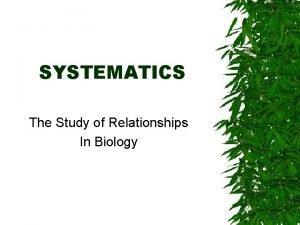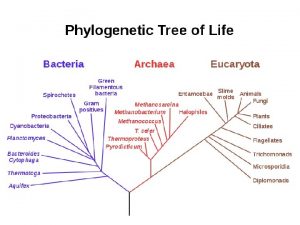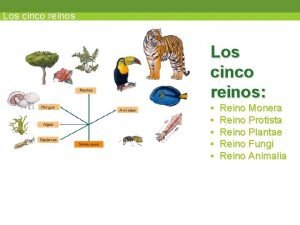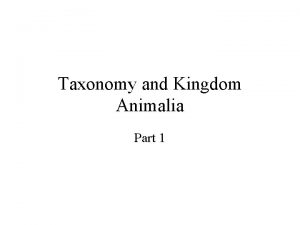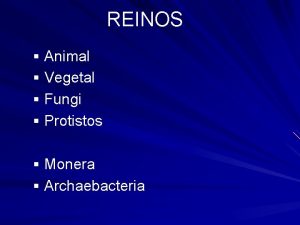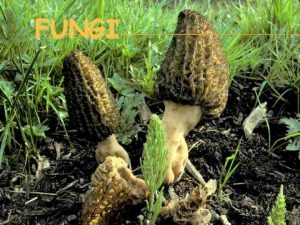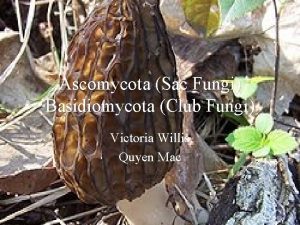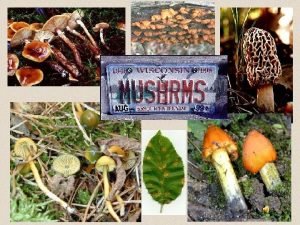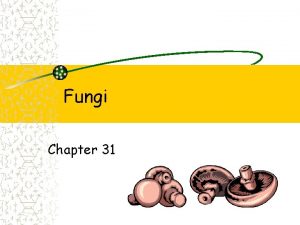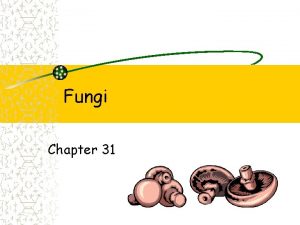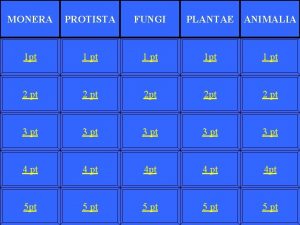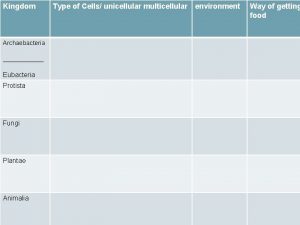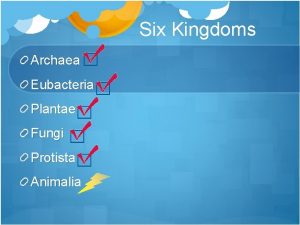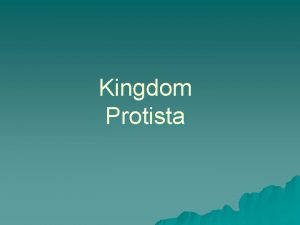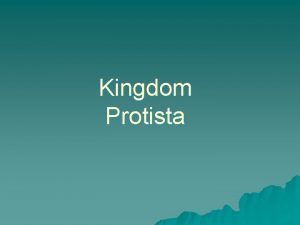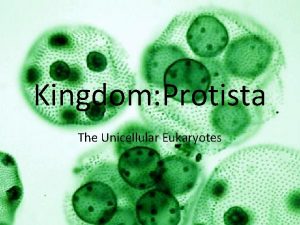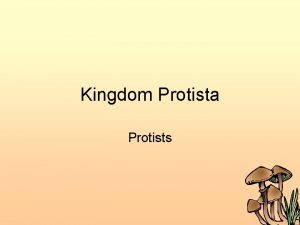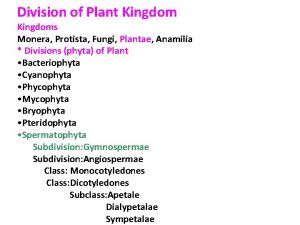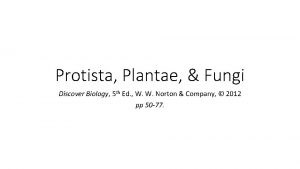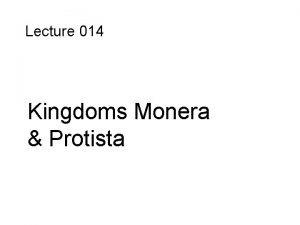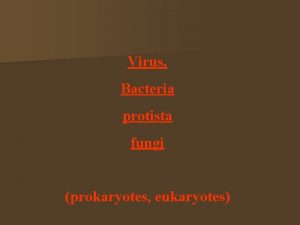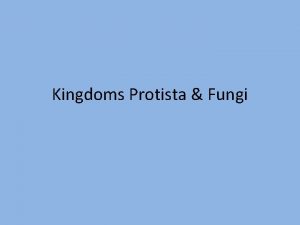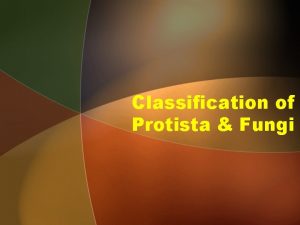Eukaryotes Protista Fungi Plantae Animalia Complex 10 x






















- Slides: 22


Eukaryotes • • • Protista, Fungi, Plantae, Animalia Complex >10 x larger DNA in nucleus Cell membrane – Some also have cell wall • Membrane bound organelles – specialization

Protista • Very diverse • mostly unicellular, some colonial, some multicellular (w/simple tissues) • Autotrophs – Plant-like • Heterotrophs – Animal-like protozoans – Fungal-like • Mixotrophs – Photoautotrophic and heterotrophic pathways • Aquatic or moist environments

Protistan origin • Eukaryotes that share some Archaea characteristics (e. g. biochemistry & genetics) – Lacks the peptidoglycons in cell walls of bacteria • Otherwise varies in modes of Eukarya reproduction, locomotion, & morphology • Endocytosis; 1 o endosymbiosis with prokaryotes (Fig 28. 3) – 2 o endosymbiosis: heterotroph engulfing red or green algae

Parabasalids Euglenozoans Excavata Diplomonads Apicomplexans Ciliates Diatoms Stramenopiles Golden algae Brown algae Chromalveolata Alveolates Dinoflagellates Oomycetes Forams Radiolarians Green algae Chlorophytes Charophytes Land plants Archaeplastida Red algae Rhizaria Cercozoans SAR clade (10 th ed) Gymnamoebas Entamoebas Opisthokonts Nucleariids Fungi Unikonta Amoebozoans Slime molds Choanoflagellates Animals Figure 28. 2

“…protist phylogeny continues to emerge… changing rapidly…”(Campbell 28. 1) • Five Supergroups: – – – Excavata Chromalveolata Rhizaria Archaeplastida Unikonta

“…it may be helpful to focus less on the specific names of groups of organisms and more on why the organisms are important…” (Campbell 28. 1) Functionally… “Animal-like” Protozoans heterotrophic consumers “Fungi-like” Protists share fungal characteristics; many moved back/forth from Fungi “Plant-like” Algae non-plant, photosynthetic aquatic eukaryotes

Figure 28. 2 Parabasalids Euglenozoans Excavata Diplomonads Apicomplexans Ciliates Diatoms Stramenopiles Golden algae Brown algae Chromalveolata Alveolates Dinoflagellates Oomycetes Forams Radiolarians Green algae Chlorophytes Charophytes Land plants Archaeplastida Red algae Rhizaria Cercozoans Gymnamoebas Entamoebas Opisthokonts Nucleariids Fungi Choanoflagellates Animals Unikonta Amoebozoans Slime molds SAR clade (10 th ed)

Diplomonads (28. 2) Excavata clade – 8 th-10 th ed. – Two nuclei – “excavated” feeding groove on one side – Multiple flagella – Usually anaerobic • Due to their modified mitochondria that lack ETCs & don’t use O 2 in respiration – E. g. Giardia • Intestinal parasite • Contaminates streams • Causes severe diarrhea

Kinetoplastids (28. 7) Excavata clade – 9 & 10 ed. Euglenozoan subclade • Kinetoplast – DNA in mitochondria • • E. g. Trypanosoma Blood parasite Single encased flagellum African Tsetse fly – Sleeping sickness (attacks nervous system; lethargy; death if untreated) • So. Amer. Kissing bugs – Chagas disease

Forams & Radiolarians Rhizaria clade – 9 & 10 ed. – Threadlike pseudopods for movement and food capture • Foraminiferans – – Have a Ca. CO 3 shell Thin extended pseudopods Planktonic or benthic Adds to the calcareous sediments • Radiolarians – Silica shells – thin pseudopods (axopodia or actinopods) – Planktonic – Comprises silicious sediments (28. 18)

Ciliates (28. 17) Chromalveolata clade – 8 & 9 ed. Alveolates subclade – 9 & 10 ed. Alveoli (vacuoles) under plasma membrane - contractile vacuoles – osmoregulation • Cilia to move and feed – E. g. Paramecium, Stentor, Vorticella • Two nuclei types – Macronucleus • Everyday activities – Micronuclei • Sexual reproduction

Apicomplexans Chromalveolata clade – 8 & 9 ed. Alveolates subclade – 9 & 10 ed. • Parasites • Apex structures for penetrating host cells • Lack cilia, flagella, or pseudopods • E. g. Plasmodium – Malaria – Enters and feeds on red blood cells – Vector = ♀ mosquitoes

Dinoflagellates Chromalveolata clade – 8 & 9 ed. Alveolates subclade – 9 & 10 ed. • Two flagella in grooves – Spinning flagellates • Planktonic – Aquatic surface drifters • Phytoplankton – Photosynthesizing – Red tides • carotenoid pigments along with chl a – Some are Mixotrophic – Some are Heterotrophic – Some are toxic • Shell fish accumulation – Bioluminescence

Diatoms Stramenopiles subclade (some stage with “hairy” flagellum) • Photoautotrophic (phytoplankton) • Silica cell wall – Glass-like – Two halves like a petri plate • Shells sink after death and accumulate as sediments • Diatomaceaous earth • Diatom reproduction • • Unique to cell structure Mitotically divide the halves Secretes the smaller half Nucleus triggers meiosis when too small

Multicellular Protists (algae) • More photoautotrophic protistans… known as: – Algae, seaweed, kelp – Thalli may be filamentous, grow in mats or crusts, sheets, or kelp • “ Plant-like” primary producers, but not plants: – Lack true leaves, stems & roots • Organized by pigment variations – Phaeophyta (browns) – Rhodophyta (reds) – Chlorophyta (greens)

Phylogeny of the once 5 “super clades” of Eukaryotes… *currently consolidated into 4 SAR clade (10 th ed) See also: Summary Table on page 598 of text (Ch 28)

Phaeophyta • Brown/yellow pigment – Fucoxanthin, some phycobilin, some carotenoids (& chl) • Diverse morphologies – Simple, small individual to large & complex (i. e. lengths up to 100 m) • kelp forest communities • Some exhibit rapid growth – 1 to 2 feet a day – Important source of algin • Thickener, stabilizer, emulsifier in many products

Rhodophyta • Red pigments – Phycoerythrin, Phycobilins, carotenoids • As a group, expands to greater depths than other algae – Why? • Includes some coralline algae – Ca. CO 3 in cell walls • Defense and structure • Important component of coral reef environments • Filamentous or Encrusting • Commercial uses – Source of carrageenan & agar (emulsifiers & gel thickeners) • Food – Nori (sushi wraps) from Porphyra

Chlorophyta • Green pigments – Chl a & Chl b – Same as plants • Diverse morphologies – – Filamentous Sheets Spongy Calcareous • Important component of coral reef environments

Other Chlorophytan examples • Colonial • plant-like chloroplasts – Volvox – Ulothrix – Spyrogyra

Amoeboids (28. 5) Unikonta clade – 9 & 10 ed. Amoebozoan subclade • Lobate pseudopodia – extensions of the cell • Locomotion • Feeding • Various environments – Aquatic; parasitic; moist soils • Some are fungal-like – Slime Molds
 Kingdom
Kingdom Monera protista fungi plantae animalia
Monera protista fungi plantae animalia Monera protista fungi plantae animalia
Monera protista fungi plantae animalia Animalia plantae
Animalia plantae Kingdom plantae prokaryotic or eukaryotic
Kingdom plantae prokaryotic or eukaryotic Classificação taxonomica
Classificação taxonomica 5 especies del reino monera
5 especies del reino monera The animalia, plantae, and protista are _____.
The animalia, plantae, and protista are _____. Nematocysts
Nematocysts Animalia plantae
Animalia plantae Plantae
Plantae Fungi domain and kingdom
Fungi domain and kingdom Kingdom fungi and kingdom plantae similarities
Kingdom fungi and kingdom plantae similarities Reino fungi y protista
Reino fungi y protista General characteristics of fungi
General characteristics of fungi Basidiomycota examples
Basidiomycota examples Deuteromycetes
Deuteromycetes Simple and compound sentences quiz
Simple and compound sentences quiz Freud complexes
Freud complexes Pauline and bruno have a big argument
Pauline and bruno have a big argument Carly's therapist asks her to simply
Carly's therapist asks her to simply Ghon complex and ranke complex
Ghon complex and ranke complex Mbti percentages
Mbti percentages

